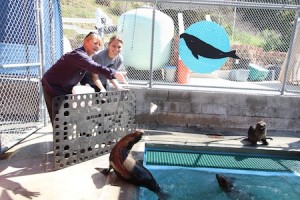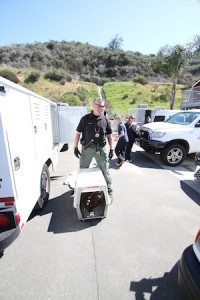
Coastal animal services officer Dana Friedman slipped a bony and listless 20-pound sea lion pup out of his rescue truck and into a portable dog cage and carried it into the Pacific Marine Mammal Center here early Wednesday afternoon.
Forty pounds underweight, the sickly sea lion pup was taken inside and swaddled in warm blankets, the 118th in a barrage of sick, young pinnipeds flooding the red barn sea animal rescue center on Laguna Canyon Road this year. The sea lion was found shivering on rocks near the surf in San Clemente by a beachgoer, who immediately called animal services for help.
Friedman asked Michelle Hunter, PMMC’s director of animal care, if he could name the precarious pup Lucky as requested by the woman who helped him carry the docile creature up 400 beach steps to the bluff where he parked his rescue truck. “Lucky it is,” Hunter replied, adding that the date, 3-13-13, seemed auspiciously lucky, too.
PMMC staff and volunteers, including a full-time veterinarian, have been working under emergency conditions and up to 14 hours a day at the rescue center in recent weeks, trying to save as many of the sick sea lion pups as possible that are now crowding the center’s cages, pens and pools. Of those rescued, 22 have died, Hunter said.
Most of the group are eight to nine months old and would normally weigh about 60 pounds. These pups are weighing in at 22 pounds or less and are considered in Stage 3 condition, or near death, said staff veterinarian Richard Evans.
“This is the final stage,” said Evans, “so we know we’ve got a problem.”

Last Saturday, a record-breaking 12 pups were rescued along the coastline from San Onofre to Seal Beach. They were severely dehydrated, malnourished and emaciated, said PMMC spokesperson Melissa Sciacca. Six more were rescued on Sunday and two on Monday. The weakened and stranded pups were found on beaches, rocks and ledges along the coast, where they climbed out of the water, struggling to breathe, to rest and, hopefully, get warm.
No exact cause of the debilitating condition has been determined yet, said Keith Matassa, the center’s executive director. Two ideas being considered are that the fish sea lions feed on have moved to deeper waters, causing nursing mothers to stay away from their pups for longer periods, or that the mothers themselves are malnourished and not producing enough milk. The center is working with scientists from the National Marine Fisheries Service in Long Beach to solidify theories.
Sarah Wilkin, marine mammal and sea turtle stranding coordinator at the Long Beach office, said researchers are trying to find what’s changed in the ocean this year over previous years. The suspicion, she said, is that it’s more of a regional phenomenon than an oceanic one like warmer Pacific Ocean water temperatures produced by past El Nino conditions that pushes the fish food chain to colder waters.
“Maybe something happened just off Southern California, for instance, that would have caused some changes in the prey bait,” she said, referring to the fish that sea lions feed on. For the moment, she said, scientists are ruling out a human cause, such as pollutants. In 2009, she explained, weather changed feeding patterns.
“The winds that typically blow on shore just stopped that year,” she said. “It resulted in a lack of upwelling, which meant the prey that these animals feed on was out of reach, particularly for these pups.” A shift in wind patterns, current patterns, fish population patterns or ocean temperatures in a small space when sea lion pups are still suckling could result in malnourishment, Wilkin said.
When the mother doesn’t return promptly because she’s feeding at deeper depths or farther away, said Matassa, “the pup gets a little bit hungry and goes off the beach trying to hunt for itself, and it’s not ready to do that.”
PMMC functions as a hospital, particularly an emergency room, without determining the origin of their patients’ illness, said Sciacca.
Rescues started in mid-January, which is unusual because the center usually starts seeing an increase in sick animals in April or May. About 15 of the 118 rescues were found along Laguna’s coastline. “It certainly doesn’t show any signs of slowing down right now,” Sciacca said. The overwhelming number of rescues is taxing the marine center’s capacity and resources.
The center, the only nonprofit organization in Orange County licensed to rescue and care for marine mammals, issued an emergency appeal to donors, even asking them to drop by unflavored children’s Pedialyte to help rehydrate the sea lion pups. The sick pups are fed a blended supplement via stomach tubes three to six times a day that includes fish, Pedialyte and molasses syrup to get them energized and ready to eat whole fish again.
Recovery is purposely slow to ensure stable health, said Evans. “You can throw them a few steak dinners,” he remarked about forcing a fast recovery, “and they’d be done tomorrow.”
When the pups reach 70 pounds, 10 pounds over the normal weight to provide a reserve, they’re ready to return to the sea. Several recuperated and playful pups will be released at 9 a.m. Sunday at Crescent Bay beach. With luck, Lucky will be released in two to three months.
Matassa asks anyone who finds a stranded sea lion pup to stay back about 150 feet, take a picture with their phone and immediately call the center at 949-494-3050. Don’t push or encourage the animal to re-enter the ocean, pour water on it or to feed it, and keep dogs away, he said.
The center is also asking for donations of time, money and materials. Contact the center at 949-494-3050 or www.pacificmmc.org.
Photos by Edgar Obrand





Nice article Rita. I dealt with two sea lions today at Treasure Island during my shift as a tidepool educator. Unfortunately, a pit bull attacked and killed a sea lion pup who had beached itself on Goff Cove, and the sea lion pup who beached itself on the rocks between Aliso Creek State Beach and Treasure Island Beach, was looked at by a Laguna Beach Animal Control officer, who decided to leave it to fend for itself. When I left work today, I stopped by to see how the pup was doing and it wasn’t doing good. I don’t think it’s going to make it to the morning, when Animal Control is supposed to return to check on it. I am amazed at the number of sea lions rescued that DON”T survive. It’s such a sad, sad situation.
[…] 2013, PMMC had 151 sick animals in its care. Initial speculation was that a lack food due to an El Nino weather pattern that brings warmer water moved sea lion prey to cooler waters. That would make it more difficult […]